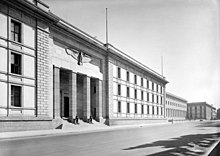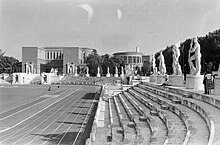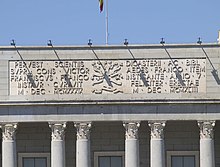
Back عمارة فاشية Arabic Arquitectura feixista Catalan Faschistische Architektur German Arquitectura fascista Spanish معماری فاشیستی Persian Architecture fasciste French אדריכלות פשיסטית HE Architettura del periodo fascista Italian Architettura fassista LMO Architetura fassista PMS
| Part of a series on |
| Fascism |
|---|
 |
Fascist architecture encompasses various stylistic trends in architecture developed by architects of fascist states, primarily in the early 20th century. Fascist architectural styles gained popularity in the late 1920s with the rise of modernism along with the ultranationalism associated with fascist governments in western Europe. Fascist styles often resemble that of ancient Rome, but can extend to modern aesthetics as well. Fascist-era buildings are frequently constructed with particular concern given to symmetry and simplicity.
Both Benito Mussolini and Adolf Hitler utilised new styles of architecture (variations of Rationalism and Stripped Classicism, respectively) as one of many attempts to unify the citizens of their states, mark a new era of nationalist culture, and exhibit the absolute rule of the state.[1]



- ^ "The Fascinating World of Fascist Architecture". Retrieved 2012-02-04.
© MMXXIII Rich X Search. We shall prevail. All rights reserved. Rich X Search